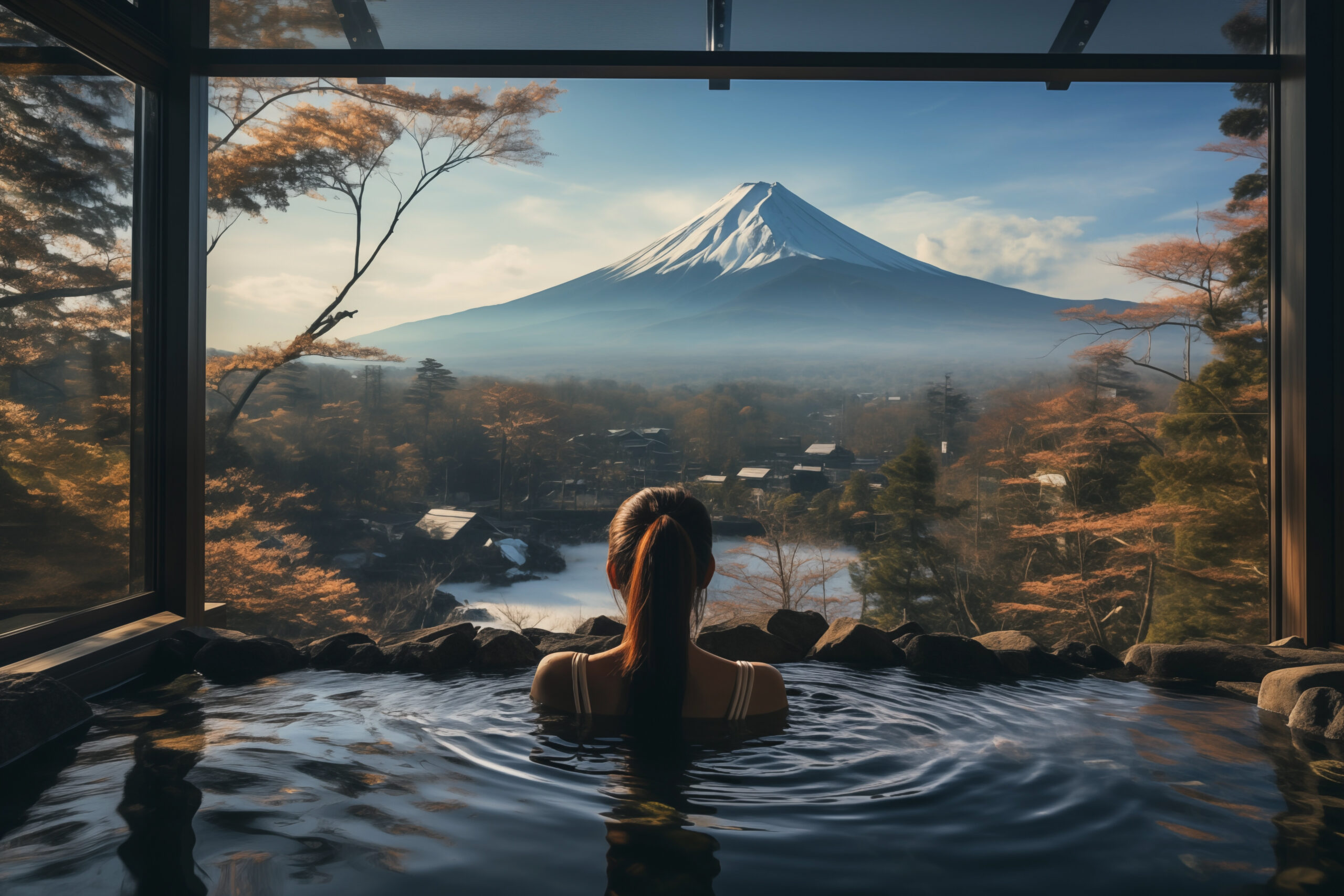In a world that moves at a breakneck pace, finding moments of calm and serenity is more crucial than ever. Japan, with its rich heritage and deep-seated traditions, offers a unique sanctuary through its bathing culture. This ancient practice, which goes beyond mere cleansing, is a path to tranquility, wellness, and a deeper connection with oneself. As we dive into the meditative waters of Japan’s baths, we uncover a transformative experience that harmonizes body, mind, and spirit.
Embracing Serenity: Japan’s Meditative Baths
The serene world of Japanese baths, or ‘ofuro’, presents an oasis of tranquility. As you step into the warm embrace of the water, the hustle and bustle of everyday life begins to fade, making room for a profound sense of peace. This meditative state is not incidental but a fundamental aspect of the Japanese bathing experience, cultivated through centuries of practice and tradition. The ritualistic nature of bathing, combined with the aesthetic and sensory elements of bathhouses, creates an environment conducive to meditation and introspection. These baths serve as sanctuaries, where the act of bathing is elevated to a form of mindfulness, allowing individuals to immerse in the present moment fully.
The Art of Japanese Bathing: A Tranquil Journey
Japanese bathing is not merely a physical cleansing process but a spiritual journey that nurtures tranquility. The artistry involved in Japanese baths, from the architectural design of the bathhouses to the careful selection of bath salts and oils, reflects a deep understanding of harmony and balance. Each element is chosen to enhance the soothing experience, guiding bathers on a tranquil journey. The soft sounds of water, the warmth enveloping the body, and the minimalist beauty surrounding the bather all contribute to this unique voyage of relaxation and self-discovery.
From Onsen to Sentō: The Spectrum of Serenity
Japan’s bathing culture spans a spectrum from the natural hot springs, or ‘onsen’, to the public bathhouses, or ‘sentō’. Each offers a distinct experience but shares the common goal of providing a haven of peace. Onsen, with their mineral-rich waters, offer a connection to nature and its healing powers, while sentō, often adorned with art and thoughtful design, provide a community space for relaxation and renewal. Both environments foster a sense of serenity, inviting bathers to leave behind the external world and embark on a journey inward.
The Rituals of Water: Bathing as a Meditative Act
Bathing in Japan is intertwined with rituals that enhance its meditative quality. The act of washing before entering the bath, the practice of soaking in silence, and the mindfulness of moving slowly and deliberately, all serve to center the bather’s mind. These rituals, passed down through generations, are not mere formalities but essential components of the bathing experience. They encourage a mindful approach to the act of bathing, transforming it into a meditative practice that nurtures calm and clarity.
Japan’s Gift to Wellness: The Therapeutic Bath
The therapeutic benefits of Japanese baths go beyond relaxation. The combination of hot water, minerals, and the tranquil bathhouse environment can have profound effects on physical and mental well-being. Studies suggest that regular bathing can improve cardiovascular health, relieve stress, and promote better sleep. Furthermore, the communal aspect of bathhouses offers a sense of belonging and community, contributing to overall happiness and life satisfaction. In this way, the Japanese bath emerges as a holistic wellness practice, addressing the needs of the body, mind, and spirit.
The Healing Waters: Exploring Japan’s Hot Springs
Japan’s geothermal activity has blessed it with thousands of natural hot springs, each with unique mineral compositions offering different health benefits. Travelers and locals alike flock to these onsen to soak in the healing waters, surrounded by Japan’s breathtaking natural landscapes. From the sulfur springs believed to detoxify the skin to the iron-rich waters that improve circulation, these hot springs provide a natural remedy for a myriad of ailments. The experience of bathing in an onsen is not only physically rejuvenating but also spiritually uplifting, as it connects bathers with the ancient land and its healing traditions.
Mindfulness in Motion: The Practice of Bathing
The Japanese bath is a practice of mindfulness in motion. Every step, from washing to soaking, is an opportunity to engage in mindful observation and to practice being fully present. This active participation in each moment of the bathing process helps cultivate a meditative mindset that can extend beyond the bathhouse into daily life. By fostering mindfulness, Japanese baths teach a valuable lesson in appreciating the here and now, encouraging a life lived with intention and awareness.
Bathing Through the Ages: A Historical Perspective
Japan’s bathing culture has evolved over centuries, deeply rooted in the country’s history and traditions. Originally, baths were communal, serving as social hubs and places of communal ritual. Over time, they have transformed, influenced by Buddhist practices of purification and Shinto concepts of cleanliness. This rich history is reflected in the diversity of bathing practices and the deep respect for the ritual of bathing that pervades Japanese culture. Understanding this historical context enriches the bathing experience, providing insight into the cultural significance of this cherished practice.
The Science Behind the Soak: Benefits of Bathing
Modern science has begun to uncover the myriad benefits of bathing, supporting what Japanese traditions have long known. The act of bathing, particularly in warm water, can stimulate the nervous system, reduce levels of stress hormones, and increase the flow of endorphins. The heat and buoyancy of the water can also alleviate muscle tension and pain, promote better sleep, and even lower blood pressure. These physiological effects, combined with the meditative aspect of bathing, make it a powerful tool for holistic health and well-being.
Community and Solitude: Bathing’s Social Aspect
While many associate bathing with solitude and introspection, in Japan, it also has a significant social component. Public bathhouses and communal hot springs serve as gathering places where people can relax and connect with one another. This social aspect of bathing contributes to its therapeutic benefits, offering a sense of community and belonging. Whether in conversation with fellow bathers or in shared silence, the communal experience of bathing fosters a unique bond, highlighting the interconnectedness of individual and collective well-being.
Beyond the Bath: Complementary Practices
The Japanese approach to wellness extends beyond the bath, incorporating various practices that complement the benefits of bathing. From the dietary traditions of kaiseki meals, rich in seasonal and local ingredients, to the physical and mental discipline of martial arts and meditation, these practices offer a holistic approach to health. Integrating these practices with regular bathing can enhance the benefits of each, leading to a more balanced and mindful lifestyle.
Immersing in Tranquility: Where to Experience Japan’s Bathing Culture
For those seeking to immerse themselves in the tranquility of Japan’s bathing culture, there are countless options across the country. From the historic hot springs of Hakone and the snow-covered baths of Hokkaido to the vibrant sentō of Tokyo, each offers a unique window into this meditative practice. These destinations not only provide a place for physical and spiritual rejuvenation but also offer a deeper connection to Japanese culture and its timeless pursuit of harmony and well-being.
Japan’s bathing culture offers a profound journey into tranquility, wellness, and self-discovery. Through its rich traditions, rituals, and practices, bathing becomes more than just a physical cleanse—it becomes a meditative act that nurtures the mind, body, and spirit. As we explore the depth and diversity of Japan’s baths, we are reminded of the power of water to heal, renew, and connect us to ourselves and the world around us. In the warm embrace of Japan’s baths, we find a sanctuary of serenity, a place where we can pause, reflect, and emerge refreshed and rejuvenated.







